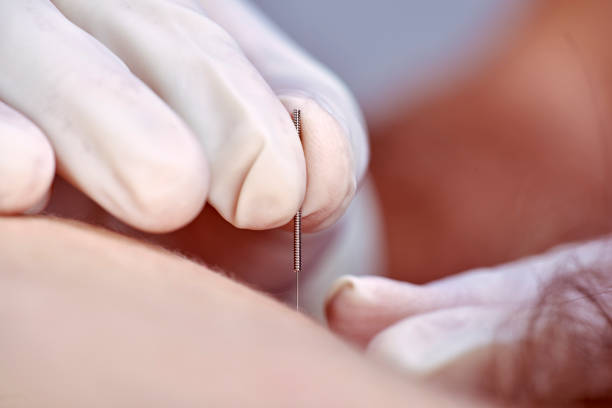Dry needling is making much noise in physical therapy and pain control. But what is it? And how can it help with things like piriformis syndrome and damaged discs? Find out what dry needling is how it works and how it compares to other types of treatment in this in-depth look. Put your feet up and let’s get going
How does dry needling work?
- How It Works: Dry needling is a method in which thin needles are put into trigger points, which are certain spots in the muscles. The goal is to lessen pain and improve performance by releasing tension. Not at all like acupuncture; more on that later.
- The general view in science: Inserting these needles into a muscle induces slight tissue injury, which might sound frightening but is actually beneficial. This process boosts blood circulation, alleviates stress, and prompts the body’s natural healing response to this minor trauma.
For Piriformis Syndrome, dry needling is used.
Piriformis disease can hurt you in the buttocks. It happens when the piriformis muscle, deep in the hip, pulls on the sciatic nerve. Ouch!
- Why dry needling is suitable: Dry needling can help relieve pain and tightness in the piriformis muscle by focusing on the trigger points in that muscle. It’s like giving that annoying muscle a little push to tell it to calm down and stop making trouble.
- The Good News: After dry needling treatments, many people with piriformis syndrome said they felt much better. Even though it might not be a cure-all, it’s still something you should consider if you have this problem.
Herniated Discs: Dry Needling
A slipped disc, another name for a bulging disc, can cause a lot of pain and soreness in the back. It happens when the soft center of a spinal disc pushes through a crack in the more challenging outside.
- What is dry needling for? Even though it can’t “fix” a bulging disc, it can help handle the pain. Focusing on trigger points near the area that hurts can relieve muscle tightness and pain.
- What Experts Say: Many physical therapists suggest dry needling to treat bulging discs and other treatments. It’s not an alternative to other treatments, but it can be a helpful way to deal with pain.
Compared to other treatments, dry needling
You might think, “This all sounds great, but how does dry needling compare to other treatments?” Wonderful question!
- Acupuncture vs. Dry Needling: Both involve putting needles in, but their goals differ. With acupuncture, the goal is to get the body’s energy in balance, while dry needling is used to relieve muscle tightness.
- Dry needling versus massage: Both can ease muscle tightness, but dry needling can reach more profound trigger points that a massage might not get.
New ideas that can’t be found anywhere else
- How Reddit Fits In On Reddit, more and more people are discussing the benefits of dry needling. Many people have discussed how well it worked for them, especially for piriformis syndrome and ruptured discs.
- First, Safety: Even though dry needling is usually safe, you should only get it done by a trained expert. Think about how deep those needles are going into your muscles.
You may also like to read The Webster Technique
Should I Needle or Should I Not Needle?
Dry needling is a potential treatment for people with piriformis syndrome and bulging discs who are in pain. It can’t fix everything but it could help. Hey if a lot of people on Reddit say it’s great maybe we should give it a try or a needle.

Frequently Asked Questions
Here are some of the frequently asked questions
– Does dry needling help with piriformis syndrome?
Yes, dry needling can help those with piriformis syndrome. Piriformis syndrome happens when the deep in the buttocks piriformis muscle pushes on the sciatic nerve, causing pain and soreness. Dry needling targets the trigger points in the piriformis muscle, which helps to release tightness and relieve pain. Many people with piriformis syndrome have said that dry-needling sessions immensely helped their problems.
– Can dry needling touch the sciatic nerve?
Even though dry needling aims to target muscle trigger points and not nerves, the sciatic nerve can be accidentally hit, especially when the piriformis muscle is being treated; this is why it’s essential to get help from a trained and experienced professional who knows the body and can reduce these risks.
– Does dry needling work on nerves?
Answer: During dry needling, there is a chance of hitting a nerve. But this risk is kept to a minimum when a trained professional does the job. If a nerve is touched by mistake, the person might feel a short electric shock. It’s essential to let the practitioner know if you feel anything strange during the process.
– When dry needling, what places should you avoid?
Some places are at higher risk for dry needling because they are close to essential body parts, like significant blood systems, nerves, and organs. Some of these places are the front of the neck, where the carotid artery and other vital organs are.
- The chest (there’s a chance of getting a hole in the lungs)
- The abdomen (because of the organs there)
- Close to the eyes or other parts of the face
– What are five times when dry needling shouldn’t be used?
Contraindications are situations or things that make a treatment or process, not a good idea. Here are five times when dry needling shouldn’t be done:
Local Infection: Dry needling shouldn’t be done in places with open wounds or skin diseases.
Bleeding Disorders: People with hemophilia or other bleeding disorders may bleed or bruise more easily.
Fear of Needles: There might be better choices than dry needling for people afraid of needles.
Pregnancy: Even though it’s not an absolute no-no, dry needling is usually not suitable for pregnant women, especially in the abdomen and lower back.
Local cancer: Dry needling shouldn’t be done where a tumor or cancer is known to be.
– Where does dry needling work best?
Answer: Dry needling works best on muscle trigger points that cause pain, tightness, or a limited range of motion. Dry needling has worked well in many places like the upper shoulder, buttocks, and leg muscles.
The muscles of the legs such as the quadriceps and hamstrings. The forces of the wrist are often affected by conditions like tennis elbow.
But how well it works relies on how the person feels, how skilled the person doing the massage is, and which muscles are being worked on.
Remember that dry needling can help with many problems, but you must talk to a doctor to ensure it’s the proper treatment.
About Author
Dr. Jeremiah Carlson is a licensed chiropractor serving the Jacksonville community. Dr. Carlson has been improving Jacksonville’s health for over 15 years. As a chiropractor with experience, Dr. Carlson is committed to finding the proper diagnosis while promoting optimal health and well-being of his patients. Following diagnosis he will evaluate for misalignments in the spine and then use chiropractic manipulation to correct them. Correcting spinal misalignments can reduce joint pain, relax spasmed muscles and calm overactive nerves. Dr. Carlson’s approach is to create balance between the joints, muscles and nerves to reduce or eliminate pain.


